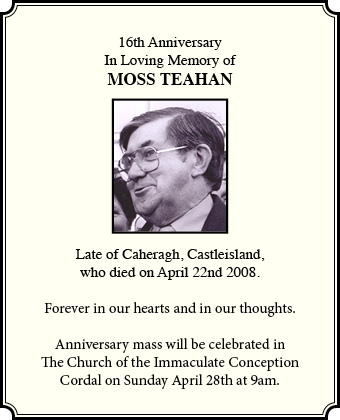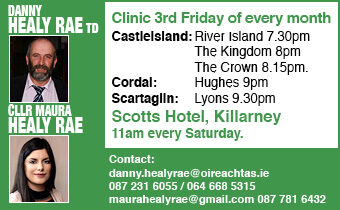
Houses and homes may not have been flooded here in the course of the worst recorded spell of weather recently. However, there were many locals whose eyes welled up and hearts bled for loved ones lying in flood covered graves in Kilbanivane – yet again.
Since early December, Maher’s side of the cemetery has been under water on at least four occasions with the latest being only last Monday. Kilbanivane has a long history of such occurrences and there are people who believe there is no solution in sight.
The Good News
The good news on that score is that there is a very firm plan in place to tackle the problem there. However, the solution is entirely dependent on the timing of the completion of work on a bottle-necked culvert under the Cordal Road in Tullig beside Walsh’s Farm Machinery.
Kerry County Council Area Engineer, Brendan Mulhern explained that the work to solve the problem of flooding at Kilbanivane will involve taking a 30cm pipeline from the main road along the 800 or so yards to the bridge on the Anglore stream at Churchtown.
That’s the same stream which eventually flooded Walsh’s Garage in Tullig in 2014 and went within inches of going into houses there.
As for the sluggeragh in Maher’s field – across the road from the graveyard – Mr. Mulhern confirmed its existence.
Cave System Flooded
“We know it’s there of course and we’ve cleared the silt from it from time to time but it can never be a solution to the flooding at Kilbanivane. This is mainly because the cave system underneath gets flooded with the kind of rain fall levels we’re getting and can’t take the surplus water which then floods the field and across the road in the graveyard.
“We have the plan to rid Kilbanivane of flooding but we can’t go ahead until the culvert problem under the road at Tullig is sorted first,” Mr. Mulhern said.
Acting on a request from a resident in the Tullig area in March 2014, Cllr. John Joe Culloty investigated the culvert under the Cordal Road.
I went with him and what he discovered there explained everything about the cause of the flood two month before.
Minister Phil Hogan
We loosened and took out a branch of a tree which remained locked in place where the flood waters hit a shoulder as the pipe under the road was reduced in half and thereby causing the back-up and the flood.
Politicians of all hues and none are well aware of this. Cllr. Danny Healy Rae spent a day up to his knees in water during the 2014 flood and he pushed for the work done on the river at Ballinahown.
At around the same time Cllr. Bobby O’Connell caught Environment Minister Phil Hogan with his coat in his hand as he was about to head for Europe. Cllr. O’Connell managed to get a pledge of a substantial sum of money to sort out the Tullig area and prevent the threat of further flooding there.
East to Churchtown
Now, those whose eyes flood when they see the final resting places of their loved ones under water can look with hope to a time when they can rest there with the dignity they deserve. The flood water at Kilbanivane may have to go east to Churchtown before going west to Castlemaine – but at least it will be going.
The time of this happening will all depend on the political will to provide that vital, last push to the work on the culvert in Tullig and to the laying of the 800 yard-long pipeline from Kilbanivane to Churchtown – the plans are there.





















































